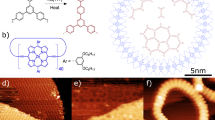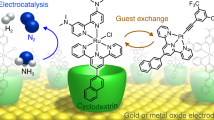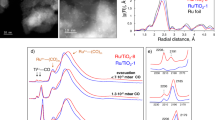Abstract
Molecular imprinting of polymer matrices enables the creation of template-shaped cavities with high affinity for molecules of given shape and size. Here we introduce a surface molecular imprinting strategy to control the hydrogenation selectivity of various aromatic molecules over a supported palladium catalyst. This strategy involves the sequential adsorption over the metal surface of an aromatic template molecule followed by poisoners, resulting in the formation of non-poisoned active islands of predetermined shape and size. Because of steric constraints, these active islands exhibit high selectivity in the chemical conversion of aromatic molecules that correspond in size and shape to the templates. The elaborated strategy enables a practical application relevant to selective hydrogenation and removal of carcinogenic benzene from mixtures of aromatics.

This is a preview of subscription content, access via your institution
Access options
Access Nature and 54 other Nature Portfolio journals
Get Nature+, our best-value online-access subscription
$29.99 / 30 days
cancel any time
Subscribe to this journal
Receive 12 digital issues and online access to articles
$119.00 per year
only $9.92 per issue
Buy this article
- Purchase on Springer Link
- Instant access to full article PDF
Prices may be subject to local taxes which are calculated during checkout








Similar content being viewed by others
Data availability
All data are available from the authors upon reasonable request. Source data for all relevant catalytic runs are provided and are also available via the NextCloud repository of Lille University (https://nextcloud.univ-lille.fr/index.php/s/nEfMjomadjapRWM).
References
van Deelen, T. W., Hernández Mejía, C. & de Jong, K. P. Control of metal–support interactions in heterogeneous catalysts to enhance activity and selectivity. Nat. Catal. 2, 955–970 (2019).
Kang, J. et al. Single-pass transformation of syngas into ethanol with high selectivity by triple tandem catalysis. Nat. Commun. 11, 827 (2020).
Liu, P., Qin, R., Fu, G. & Zheng, N. Surface coordination chemistry of metal nanomaterials. J. Am. Chem. Soc. 139, 2122–2131 (2017).
Wang, C. et al. Maximizing sinusoidal channels of HZSM-5 for high shape-selectivity to p-xylene. Nat. Commun. 10, 4348 (2019).
Cui, T. L. et al. Encapsulating palladium nanoparticles inside mesoporous MFI zeolite nanocrystals for shape-selective catalysis. Angew. Chem. Int. Ed. 55, 9178–9182 (2016).
Howarth, A. J. et al. Chemical, thermal and mechanical stabilities of metal–organic frameworks. Nat. Rev. Mater. 1, 15018 (2016).
Bai, R., Song, Y., Li, Y. & Yu, J. Creating hierarchical pores in zeolite catalysts. Trends Chem. 1, 601–611 (2019).
Katz, A. & Davis, M. E. Molecular imprinting of bulk, microporous silica. Nature 403, 286–289 (2000).
Chen, L., Wang, X., Lu, W., Wu, X. & Li, J. Molecular imprinting: perspectives and applications. Chem. Soc. Rev. 45, 2137–2211 (2016).
Mahon, C. S. & Fulton, D. A. Mimicking nature with synthetic macromolecules capable of recognition. Nat. Chem. 6, 665–672 (2014).
Vladimir, M., Mirsky, T. H., Piletsky, S. A. & Wolfbeis, O. S. A spreader-bar approach to molecular architecture: formation of stable artificial chemoreceptors. Angew. Chem. Int. Ed. 38, 1108–1110 (1999).
Canlas, C. P. et al. Shape-selective sieving layers on an oxide catalyst surface. Nat. Chem. 4, 1030–1036 (2012).
Li, Z. et al. Well-defined materials for heterogeneous catalysis: from nanoparticles to isolated single-atom sites. Chem. Rev. 120, 623–682 (2020).
Wu, D. et al. In-situ generation of Brønsted acidity in the Pd-I bifunctional catalysts for selective reductive etherification of carbonyl compounds under mild conditions. ACS Catal. 9, 2940–2948 (2019).
Marshall, S. T. et al. Controlled selectivity for palladium catalysts using self-assembled monolayers. Nat. Mater. 9, 853–858 (2010).
Wu, D. et al. Dual metal–acid Pd–Br catalyst for selective hydrodeoxygenation of 5-hydroxymethylfurfural (HMF) to 2,5-dimethylfuran at ambient temperature. ACS Catal. 11, 19–30 (2020).
Pang, S. H., Schoenbaum, C. A., Schwartz, D. K. & Medlin, J. W. Directing reaction pathways by catalyst active-site selection using self-assembled monolayers. Nat. Commun. 4, 2448 (2013).
Liu, X. et al. Oxide-nanotrap-anchored platinum nanoparticles with high activity and sintering resistance by area-se lective atomic layer deposition. Angew. Chem. Int. Ed. 56, 1648–1652 (2017).
Zhao, X. et al. Thiol treatment creates selective palladium catalysts for semihydrogenation of internal alkynes. Chem 4, 1080–1091 (2018).
Wu, D. et al. Lignin compounds to monoaromatics: selective cleavage of C–O bonds over brominated ruthenium catalyst. Angew. Chem. Int. Ed. 60, 12513–12523 (2021).
Xian, J., Hua, Q., Jiang, Z., Ma, Y. & Huang, W. Size-dependent interaction of the poly(N-vinyl-2-pyrrolidone) capping ligand with Pd nanocrystals. Langmuir 28, 6736–6741 (2012).
Arrigo, R. et al. Nature of the N–Pd interaction in nitrogen-doped carbon nanotube catalysts. ACS Catal. 5, 2740–2753 (2015).
Wu, B., Huang, H., Yang, J., Zheng, N. & Fu, G. Selective hydrogenation of α,β-unsaturated aldehydes catalyzed by amine-capped platinum–cobalt nanocrystals. Angew. Chem. Int. Ed. 51, 3440–3443 (2012).
Du, Y., Chen, H., Chen, R. & Xu, N. Poisoning effect of some nitrogen compounds on nano-sized nickel catalysts in p-nitrophenol hydrogenation. Chem. Eng. J. 125, 9–14 (2006).
Chen, J. J. & Winograd, N. The adsorption and decomposition of methylamine on Pd (111). Surf. Sci. 326, 285–300 (1995).
Ding, S. Y. et al. Construction of covalent organic framework for catalysis: Pd/COF-LZU1 in Suzuki–Miyaura coupling reaction. J. Am. Chem. Soc. 133, 19816–19822 (2011).
Vogt, L., Schulte, E., Collins, S. & Quaino, P. Theoretical and FTIR investigations of the acetonitrile hydrogenation pathways on platinum. Top. Catal. 62, 1076–1085 (2019).
He, Q., Kusumi, R., Kimura, S., Kim, U. J. & Wada, M. Cationic hydrogels prepared from regioselectively azidated (1-3)-α-d-glucan via crosslinking and amination: physical and adsorption properties. Carbohydr. Polym. 245, 116543 (2020).
Thorn, K. A. & Kennedy, K. R. 15N NMR investigation of the covalent binding of reduced TNT amines to soil humic acid, model compounds, and lignocellulose. Environ. Sci. Technol. 36, 3787–3796 (2002).
Yu, Y., Zhao, Y., Huang, T. & Liu, H. Shape-controlled synthesis of palladium nanocrystals by microwave irradiation. Pure Appl. Chem. 81, 2377–2385 (2009).
Rahaman, M., Dutta, A. & Broekmann, P. Size-dependent activity of palladium nanoparticles: efficient conversion of CO2 into formate at low overpotentials. ChemSusChem 10, 1733–1741 (2017).
Rao, R. G. et al. Interfacial charge distributions in carbon-supported palladium catalysts. Nat. Commun. 8, 340 (2017).
Chen, G. et al. Interfacial electronic effects control the reaction selectivity of platinum catalysts. Nat. Mater. 15, 564–569 (2016).
Bachiller-Baeza, B. & Anderson, J. A. FTIR and reaction studies of styrene and toluene over silica–zirconia-supported heteropoly acid catalysts. J. Catal. 212, 231–239 (2002).
Hamm, G. et al. The adsorption of benzene on Pd(111) and ordered Sn/Pd(111) surface alloys. Surf. Sci. 562, 170–182 (2004).
Ioannides, T. & Verykios, X. E. The interaction of benzene and toluene with Rh dispersed on SiO2, Al2O3, and TiO2 carriers. J. Catal. 143, 175–186 (1993).
Campisi, S. et al. Selectivity control in palladium-catalyzed alcohol oxidation through selective blocking of active sites. J. Phys. Chem. C. 120, 14027–14033 (2016).
Komanoya, T., Kinemura, T., Kita, Y., Kamata, K. & Hara, M. Electronic effect of ruthenium nanoparticles on efficient reductive amination of carbonyl compounds. J. Am. Chem. Soc. 139, 11493–11499 (2017).
Lu, J. et al. Toward atomically-precise synthesis of supported bimetallic nanoparticles using atomic layer deposition. Nat. Commun. 5, 3264 (2014).
Wang, X. et al. Palladium–platinum core–shell icosahedra with substantially enhanced activity and durability towards oxygen reduction. Nat. Commun. 6, 7594 (2015).
Tait, S. L. et al. One-dimensional self-assembled molecular chains on Cu(100): interplay between surface-assisted coordination chemistry and substrate commensurability. J. Phys. Chem. C. 111, 10982–10987 (2007).
Abdala, P. M. et al. Scientific opportunities for heterogeneous catalysis research at the SuperXAS and SNBL beam lines. Chim. (Aarau) 66, 699–705 (2012).
Vasiurrahaman, M. The hydrogenation of toluene and o-, m-, and p-xylene over palladium ii. Reaction model. J. Catal. 127, 267–275 (1991).
Poondi, D. & Albert Vannice, M. Competitive hydrogenation of benzene and toluene on palladium and platinum catalysts. J. Catal. 161, 742–751 (1996).
Stolbov, S. & Rahman, T. S. First-principles study of some factors controlling the rate of ammonia decomposition on Ni and Pd surfaces. J. Chem. Phys. 123, 204716 (2005).
Hoft, R. C., Ford, M. J., McDonagh, A. M. & Cortie, M. B. Adsorption of amine compounds on the Au(111) surface: a density functional study. J. Phys. Chem. C. 111, 13886–13891 (2007).
Dai, C. et al. Deactivation study of Pd/Al2O3 catalyst for hydrogenation of benzonitrile in fixed-bed reactor. Appl. Catal. A Gen. 538, 199–206 (2017).
Guo, M. et al. Improving catalytic hydrogenation performance of Pd nanoparticles by electronic modulation using phosphine ligands. ACS Catal. 8, 6476–6485 (2018).
Tsunoyama, H., Ichikuni, N., Sakurai, H. & Tsukuda, T. Effect of electronic structures of Au clusters stabilized by poly(N-vinyl-2-pyrrolidone) on aerobic oxidation catalysis. J. Am. Chem. Soc. 131, 7086–7093 (2009).
Pushkarev, V. V., An, K., Alayoglu, S., Beaumont, S. K. & Somorjai, G. A. Hydrogenation of benzene and toluene over size controlled Pt/SBA-15 catalysts: elucidation of the Pt particle size effect on reaction kinetics. J. Catal. 292, 64–72 (2012).
Verma, D. K. & des Tombe, K. Benzene in gasoline and crude oil: occupational and environmental implications. AIHA J. 63, 225–230 (2002).
Galadima, A. & Muraza, O. Role of zeolite catalysts for benzene removal from gasoline via alkylation: A review. Microporous Mesoporous Mater. 213, 169–180 (2015).
Savva, P. G. et al. Benzene hydrogenation over Ni/Al2O3 catalysts prepared by conventional and sol–gel techniques. Appl. Catal. B 79, 199–207 (2008).
Wang, Q. et al. Solid micellar Ru single-atom catalysts for the water-free hydrogenation of CO2 to formic acid. Appl. Catal. B 290, 120036 (2021).
Acknowledgements
The authors thank Solvay and the University of Lille for a stipend for the PhD research of D.W. and financial support of this work. The authors thank the Chevreul Institute (FR 2638) for its help in the development of this work. The authors thank O. Gardoll, B. Revel and M. Capron for characterizations of the catalysts. The Chevreul Institute and the Microscopy Platform in Lille are supported by the Ministère de l’Enseignement Supérieur et de la Recherche et de l’Innovation, the CNRS, the Région Hauts-de-France, the Métropole Européenne de Lille and the Fonds Européen de Développement des Régions.
Author information
Authors and Affiliations
Contributions
V.V.O., A.Y.K. and D.W. conceived the idea for this work. All authors contributed to the design of the experimental setup and experimental procedures. D.W. performed most of the experiments with the help of B.G. and W.Y.H. TEM analysis was performed by A.A., W.B., M.M. and O.E. XPS analysis was performed by E.I.V. O.V.S performed the XAS analysis, and N.N. performed the ToF-SIMS measurements. The project was directed by A.Y.K., V.V.O and W.Z. The manuscript was written through contributions of all authors. All authors have given approval to the final version of the manuscript.
Corresponding authors
Ethics declarations
Competing interests
The authors declare no competing interests.
Additional information
Peer review information Nature Catalysis thanks the anonymous reviewers for their contribution to the peer review of this work.
Publisher’s note Springer Nature remains neutral with regard to jurisdictional claims in published maps and institutional affiliations.
Supplementary information
Supplementary Information
Supplementary Figs. 1–19, Tables 1–3 and references.
Source data
Source Data Fig. 2
Raw data for Fig. 2
Source Data Fig. 7
Raw data for Fig. 7
Source Data Fig. 8
Raw data for Fig. 8
Rights and permissions
About this article
Cite this article
Wu, D., Baaziz, W., Gu, B. et al. Surface molecular imprinting over supported metal catalysts for size-dependent selective hydrogenation reactions. Nat Catal 4, 595–606 (2021). https://doi.org/10.1038/s41929-021-00649-3
Received:
Accepted:
Published:
Issue Date:
DOI: https://doi.org/10.1038/s41929-021-00649-3
This article is cited by
-
Liquid metals for boosting stability of zeolite catalysts in the conversion of methanol to hydrocarbons
Nature Communications (2024)
-
Approaching enzymatic catalysis with zeolites or how to select one reaction mechanism competing with others
Nature Communications (2023)
-
Fully exposed palladium cluster catalysts enable hydrogen production from nitrogen heterocycles
Nature Catalysis (2022)



